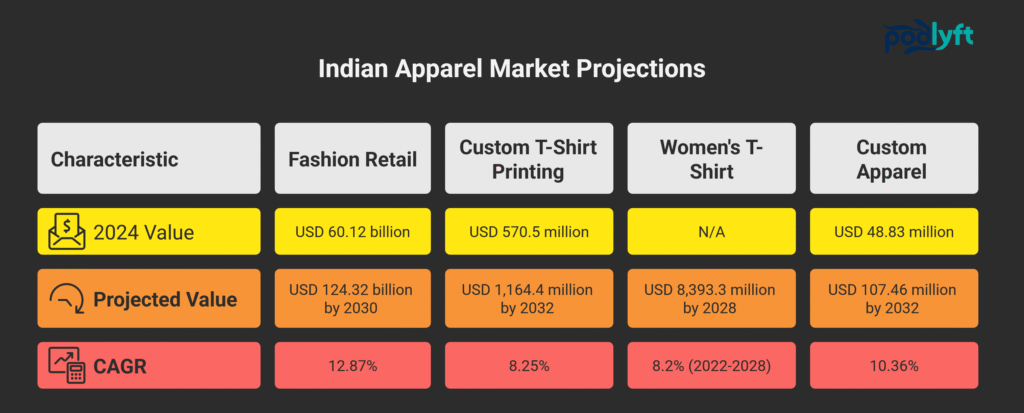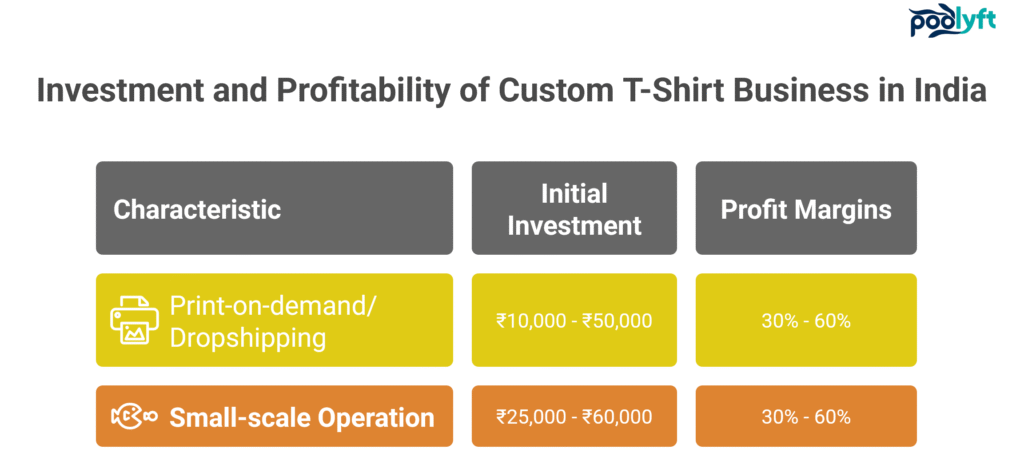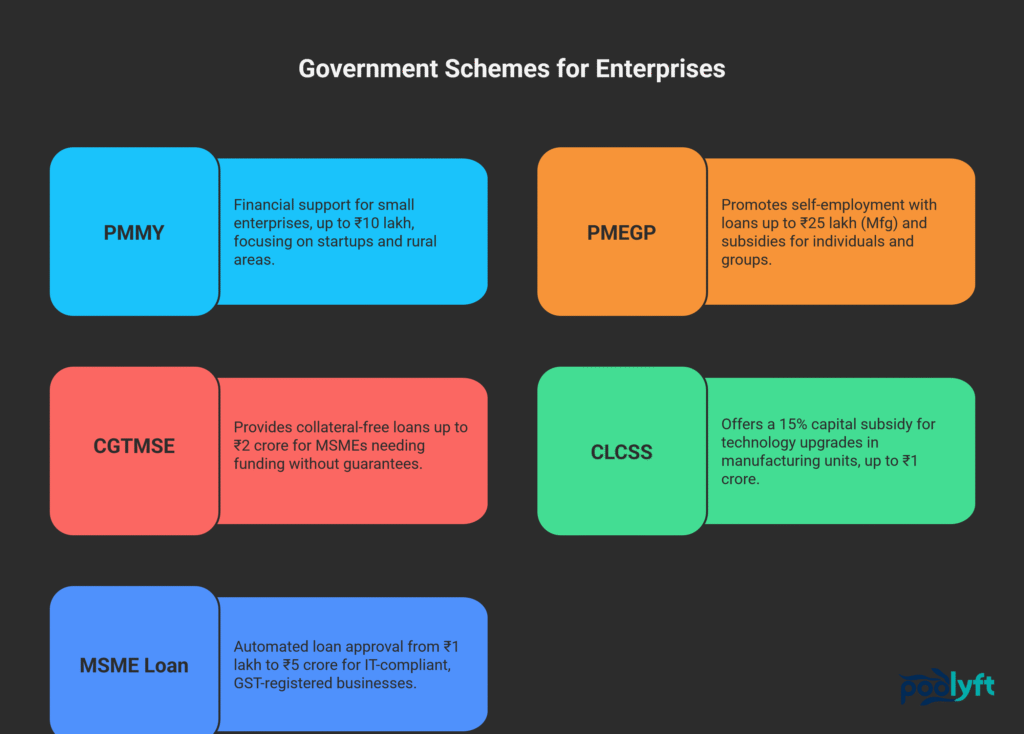Summary: India’s T-shirt market presents significant opportunities for new entrepreneurs, fueled by a young, fashion-conscious population and a rapidly growing e-commerce sector. This guide offers a comprehensive roadmap for launching a T-shirt making business, addressing key aspects such as understanding market dynamics, legal registration, design, production, marketing, and scaling the venture. It outlines practical steps, financing options, and strategies to capitalize on unique designs and digital platforms to establish a successful brand in this dynamic industry.
1. Introduction: Tapping into India’s Vibrant T-shirt Market
The Indian apparel market is experiencing a significant transformation, with T-shirts becoming a staple in contemporary wardrobes. This trend is driven by a growing youth population, rising disposable incomes, and the pervasive influence of social media.
The demand for personalized and stylish T-shirts is particularly robust, creating ample opportunities for new businesses. Launching a T-shirt manufacturing venture in India is attractive due to relatively low entry barriers and the widespread adoption of online retail.
This guide will outline the essential steps, providing practical advice and real-world examples to help navigate the market and achieve success.
2. Understanding the T-shirt Business Market in India
To succeed in the T-shirt business, a deep understanding of the Indian market’s nuances is crucial. This involves analyzing market size, identifying key trends, understanding customer preferences, and assessing the competitive landscape.
2.1. Market Size and Trends
The Indian apparel market is experiencing significant growth, driven by urbanization, increasing health consciousness, and the rise of athleisure and lifestyle-oriented fashion. The penetration of e-commerce is a key factor in enhancing access to apparel in both urban and rural areas.
According to ResearchAndMarket, the overall Indian Fashion Retail Market was valued at USD 60.12 billion in 2024 and is expected to reach USD 124.32 billion by 2030, growing at a Compound Annual Growth Rate (CAGR) of 12.87%. This growth indicates a substantial and expanding consumer base for various types of apparel, including T-shirts. Within this larger market, several distinct segments exhibit significant potential.
For example, the Indian Custom T-shirt Printing Market is projected to grow from USD 570.5 million in 2024 to an estimated USD 1,164.4 million by 2032, with a CAGR of 8.25%, as reported by Credence Research. Similarly, the Indian Women’s T-shirt Market is expected to achieve a projected revenue of USD 8,393.3 million by 2028, with a CAGR of 8.2% from 2022 to 2028.
The broader Indian Custom Apparel Market is also anticipated to grow from USD 48.83 million in 2024 to an estimated USD 107.46 million by 2032, with a CAGR of 10.36%. These figures highlight that the T-shirt market is not a single, uniform entity but rather a collection of diverse, growing segments, each offering unique opportunities.
This market structure suggests that new entrepreneurs can significantly enhance their chances of success by identifying and targeting a specific niche, allowing for more focused marketing, design, and resource allocation.

2.1.1. Rapid growth fueled by youth culture and social media
Rapid growth in these segments is driven by youth culture, the pervasive influence of social media, and increasing disposable incomes, particularly among millennials and Generation Z, who actively seek unique designs for self-expression. The rise of e-commerce platforms such as Myntra, Amazon, and Flipkart has significantly boosted sales, making custom T-shirts a fast-moving product due to their convenience and accessibility.
With internet penetration exceeding 47% of the total population, online sales are further accelerated, expanding access to apparel in both urban and rural areas. In addition to individual consumers, corporate branding and promotional activities also generate substantial demand for personalized T-shirts, as businesses utilize custom apparel to enhance visibility and strengthen brand identity.
For a new T-shirt business, prioritizing an online sales channel is not merely an option but a strategic necessity. This approach offers lower overhead costs compared to physical retail, provides a broader reach—including Tier II and Tier III cities where internet penetration is on the rise—and grants direct access to data for understanding customer preferences. Furthermore, this strategy aligns well with models like print-on-demand, which can significantly mitigate inventory risk.
2.1.2. Popular brands like Chumbak and Freakins, and PodLyft inspire local entrepreneurs
Inspirational brands such as Chumbak, Freakins, and PodLyft have successfully navigated and capitalized on the evolving Indian fashion market. Chumbak, renowned for its fusion of traditional Indian elements with contemporary design, strategically leveraged social media in its early days for marketing and fostering deep customer engagement, building a loyal following through storytelling rather than merely promotional content. Freakins, an e-commerce brand focused on denim and youth-centric fashion, scaled rapidly through targeted SEO and influencer collaborations, demonstrating the power of digital visibility in a competitive landscape.
Similarly, PodLyft—a contemporary, cause-driven custom apparel brand—has harnessed Gen Z’s desire for self-expression, personalization, and sustainability. Through limited-edition streetwear collections, social media-driven product launches, and a streamlined custom print-on-demand model, PodLyft exemplifies how a microbrand can flourish by concentrating on niche values and digital adaptability. These success stories highlight the potential of Indian entrepreneurship when grounded in authenticity, bolstered by a robust brand identity, and propelled by a targeted digital-first strategy.
Check Our Best picks
90s Retro Sweatshirt for men: Love Nostalgic Style
Original price was: ₹3,599.00.₹1,599.00Current price is: ₹1,599.00.Be Fearless T-shirt
Original price was: ₹2,899.00.₹999.00Current price is: ₹999.00.Be True to You Crop Top – for Women, Bold & Shine
Original price was: ₹2,055.00.₹699.00Current price is: ₹699.00.Beast Mode On Tee | Fiery Basketball Energy
Original price was: ₹2,099.00.₹799.00Current price is: ₹799.00.
2.2. Customer Preferences
Understanding the factors that motivate Indian consumers to purchase T-shirts is essential for developing effective design, pricing, and marketing strategies.
Indian consumers, particularly millennials and Generation Z, are increasingly seeking unique designs that reflect their personalities, interests, and affiliations. Custom-printed T-shirts have become a popular medium for self-expression, encompassing themes ranging from pop culture and social causes to personal messages. This desire for individuality suggests that generic designs may struggle to attract market attention.
2.2.1. Custom designs, eco-friendly fabrics, and affordability matter most.
Sustainability is emerging as a key trend, driven by a growing consumer preference for eco-friendly apparel. This shift is resulting in increased demand for sustainable fabrics such as organic cotton and recycled materials, as well as water-based inks.
India’s status as the world’s largest producer of organic cotton, contributing over 50% of the global supply, offers a significant advantage for local businesses to adopt sustainable practices from the outset.
This is not merely an ethical choice; it is a strategic business advantage that enables brands to engage with a growing, conscious consumer base, differentiate themselves in a competitive market, and potentially benefit from local sourcing. Ultimately, this approach can enhance brand perception and foster customer loyalty.
While quality and unique designs are important, affordability remains a significant factor for Indian consumers. The growth of the Indian middle class, currently estimated at 350 million people, has increased discretionary spending on custom clothing, making personalization a mainstream choice.
Furthermore, India’s gifting market, valued at approximately USD 65 billion, has experienced a rapid shift towards personalized gifts, including custom T-shirts, especially during festivals like Diwali and Raksha Bandhan. This cultural aspect presents a unique opportunity for businesses that offer customized apparel.
2.2.2. Preferences vary across regions—urban vs rural.
Customer preferences can vary significantly between urban and rural areas. While Western clothing, such as T-shirts, is prevalent in urban settings across all social strata, traditional attire remains dominant in many rural regions due to its ease, comfort, and accessibility.
However, the rising digital literacy and disposable income in Tier 2 and Tier 3 cities are driving a surge in demand for customized apparel. This shift, combined with globalization and increased mobility between urban and rural areas, is fostering a blending of styles.
Businesses should consider designs that resonate with a broader, evolving Indian aesthetic—perhaps integrating traditional motifs with contemporary T-shirt styles to appeal to this expanding demographic. This indicates a need for adaptable marketing and distribution strategies that recognize regional nuances while leveraging digital outreach.
2.2.3. Preferences vary across regions—urban vs rural.
Social media platforms are essential for monitoring evolving trends. Facebook, YouTube, and Instagram are particularly effective in identifying viral trends, popular sounds, and visual aesthetics that resonate with younger audiences. Following local artists and influencers can offer valuable insights into emerging styles and themes, enabling businesses to adapt their offerings swiftly.
2.3. Competitor Analysis, Niche, Target Audience, and USP
Thorough market research is the foundation of any successful business endeavor. In the custom T-shirt industry, it is essential to understand current trends, accurately identify the target audience, and establish a unique niche to achieve differentiation and sustainable growth.
2.3.1. Identify Your Target Audience and Niche
In a market described as “crowded,” simply offering generic custom T-shirts is unlikely to suffice. Therefore, avoiding a broad approach and instead focusing on specific niches is crucial for effectively targeting the right audience and standing out. A business can always expand its offerings later once it has established a strong foothold and achieved growth within its initial niche.
Potential niche markets include:
- Youth and Students: This segment often seeks custom T-shirts for college events, sports teams, and alumni associations, offering consistent demand for group orders.
- Corporations and Businesses: Companies frequently require custom apparel for branding, promotional activities, uniforms, and corporate gifting. This B2B segment can provide stable, larger-volume orders, forming a crucial revenue stream.
- Events: Custom T-shirts are popular for weddings, festivals, political campaigns, charity work, and team-building exercises.
- Specific Themes: This category encompasses diverse interests such as fitness and gym apparel, regional and cultural themes (e.g., Marathi or Tamil quotes), political or activist T-shirts, meme and humor-based shirts, and eco-friendly or organic cotton wear. The success of highly specific, sometimes quirky, niche examples available on platforms like Etsy demonstrates that serving passionate communities can be highly profitable.
- Limited Edition and Influencer Merchandise: This is a growing trend, heavily driven by social media, where exclusivity and affiliation with public figures drive consumer interest.
Geographically, metropolitan hubs such as Mumbai, Delhi, Bangalore, and Chennai currently dominate the market due to their large urban populations, diverse demographics, and robust e-commerce infrastructure. However, Tier-2 and Tier-3 cities, including Pune, Jaipur, Kochi, Lucknow, and Indore, are emerging as significant growth areas, primarily driven by increasing digital connectivity and rising disposable incomes. Businesses that can effectively bridge the digital literacy gap and offer accessible online experiences in these regions may gain a significant competitive edge.
2.3.2. Study Competitors and Find Your Unique Selling Proposition (USP)
A comprehensive analysis of competitors’ pricing, product quality, customer reviews, and market positioning is essential. The goal is to identify the “gap areas they are not addressing or where their service is lacking—that a new business could capitalize on. For example, if competitors provide oversized T-shirts made from thin fabrics and have slow delivery times, a new entrant could build trust by offering superior fabric quality and expedited shipping.
The Indian market is characterized by “Intense Market Competition and Price Sensitivity” due to the increasing number of entrants, including a substantial unorganized sector that constitutes over 80% of the country’s garment industry by volume and often operates with minimal overhead costs. This situation necessitates a compelling Unique Selling Proposition (USP).
A business’s USP may include faster shipping, attractive packaging, superior fabric quality, truly unique designs, or a strong commitment to sustainable practices. By actively addressing existing customer pain points, a business can establish a more compelling value proposition than merely being “different.”
A company that identifies and effectively resolves specific customer frustrations or unmet needs within a niche is more likely to gain rapid traction and foster strong customer loyalty, even in a competitive market.
3. Planning, Setting Up Your Business, and Registering
A well-structured venture plan serves as the essential blueprint for a t-shirt making business in India, guiding it from initial conception through to scaling and expansion. It is crucial for setting clear objectives, managing financial resources, and attracting potential investors.
3.1. Outline Your Business Goals, Budget, and Revenue Projections
A foundational business plan should thoroughly outline the venture’s vision and overarching goals, clearly define the target market, articulate the Unique Selling Proposition (USP), provide detailed budget and cost estimates, delineate marketing channels, and project anticipated revenue. Such a plan is essential, especially if the business aims to seek external funding from investors or banks.
The custom T-shirt business in India presents a significant advantage regarding initial investment. Entrepreneurs can start with a relatively low capital outlay, typically between ₹10,000 and ₹50,000, particularly when employing print-on-demand (POD) or dropshipping models.
This accessibility enables a “lean startup” approach, allowing entrepreneurs to validate their ideas and designs with minimal financial risk before committing to larger investments. This strategy fosters a more dynamic entrepreneurial ecosystem.
For a more comprehensive small-scale operation, covering aspects such as website setup, optional initial inventory, and marketing, the initial investment might range from ₹25,000–₹60,000. The industry also presents attractive profit margins, typically ranging from 30% to 60%, contingent on the chosen business model and pricing strategy.

3.2. Decide on Your Business Model: Print-on-Demand, Inventory, or Hybrid
Choosing the appropriate business model is a pivotal decision that impacts operational efficiency, cost structure, and scalability. Three common models prevail in India:
- Print-on-Demand (POD): In this model, T-shirts are printed only after a customer places an order, eliminating the need to maintain physical inventory.
- Advantages: This model requires no upfront investment in inventory, significantly minimizes material waste (making it a more sustainable option), allows for extensive customization, and is ideally suited for e-commerce operations. It provides an excellent avenue for new businesses to experiment with various designs and trends without substantial financial risk.
- Disadvantages: The cost per unit is typically higher compared to bulk production, and delivery times may be longer since printing occurs post-order. Furthermore, businesses require working capital to bridge the cash flow gap between when the customer pays the marketplace and when the POD supplier requires payment. Despite these considerations, POD is widely considered a viable and often recommended model for starting a custom T-shirt business in India, especially for new entrants, enabling rapid iteration and market validation.
- Bulk Inventory + Online Sales: This model involves producing or sourcing T-shirts in large quantities upfront.
- Advantages: It is more cost-effective for businesses with steady demand, yields higher profit margins per unit, and allows for immediate dispatch if stock is readily available. This model also grants greater control over product quality and delivery timelines.
- Disadvantages: It necessitates a significant upfront investment in inventory, requires dedicated storage space, and carries the risk of accumulating unsold stock if designs do not perform as expected.
- Hybrid Model: Many successful brands in India adopt a hybrid strategy, leveraging the strengths of both POD and bulk production. This approach involves using POD for testing new designs and validating market interest, and then transitioning best-selling designs to bulk printing to optimize costs and improve profit margins. This strategic evolution allows businesses to maintain flexibility while capitalizing on economies of scale for proven products. Starting with POD mitigates initial risk and provides market validation, which then informs more efficient production choices.
3.3. Register Your Business Legally
Establishing the legal framework for starting a T-shirt making business in India is a crucial step that fosters trust, ensures compliance with regulations, and safeguards intellectual property.
3.3.1 Choose a Business Structure
The choice of business structure significantly impacts liability, control, and future funding opportunities. The most common types in India include:
- Sole Proprietorship: This is the simplest and quickest structure to set up, often operational within 10 days without separate registration, recognized instead by other business registrations like sales tax. The owner retains full control, and profits are taxed as personal income. However, its primary drawback is unlimited liability, meaning the owner’s assets are at risk for business debts. This structure is ideal for solo founders with limited initial capital.
- Partnership Firm: Involves two or more individuals sharing responsibility and pooling capital. While relatively easy to start, especially if unregistered (requiring only a partnership deed), it also carries unlimited liability for all partners.
- Limited Liability Partnership (LLP): This structure combines the benefits of a private limited company and a general partnership. It offers limited liability, protecting partners’ assets, and provides a flexible management structure without a minimum capital requirement. It requires at least two partners and registration with the Ministry of Corporate Affairs (MCA). LLPs are suitable for businesses unlikely to require significant equity funding in the short term.
- Private Limited Company (Pvt Ltd): This is the most common business structure for medium and large-scale businesses in India. It is a separate legal entity with limited liability, making it easier to secure funding and investment and allowing for simpler transfer of ownership. It requires at least two directors and two shareholders, MCA registration, and compliance with the Companies Act.
The choice of business structure involves a trade-off. While sole proprietorships are the easiest to establish, they do not provide personal asset protection. Limited Liability Partnerships (LLPs) and Private Limited (Pvt Ltd) companies offer limited liability but come with increased compliance requirements and setup complexity.
For a T-shirt business, starting lean may favor a sole proprietorship; however, scaling up quickly necessitates considering limited liability for risk mitigation. Entrepreneurs should evaluate their risk tolerance, growth aspirations, and initial capital when selecting a business structure.
A sole proprietorship may be suitable for initial market testing, but transitioning to an LLP or a private limited company becomes advisable as the business gains traction and seeks external funding or takes on additional liabilities.
Common Business Structures in India: A Quick Guide:
| Feature | Sole Proprietorship | Partnership Firm | Limited Liability Partnership (LLP) | Private Limited Company (Pvt. Ltd.) |
| Number of Owners | 1 | 2 or more | At least 2 partners | At least 2 directors & 2 shareholders |
| Liability | Unlimited (personal assets at risk) | Unlimited (personal assets at risk for partners) | Limited (partners’ personal assets protected) | Limited (partners’ assets protected) |
| Ease of Setup | Very Easy (no separate registration) | Easy (partnership deed, optional registration) | Moderate (MCA registration) | Complex (MCA registration, legal documents) |
| Compliance | Minimal | Minimal (if unregistered) / Moderate (if registered) | Moderate | High |
| Taxation | Personal Income Tax | Personal Income Tax for partners | Corporate Tax (LLP tax rates) | Corporate Tax |
| Funding/Investment | Difficult | Difficult | Moderate (easier than proprietorship/partnership) | Easy (can raise equity funding) |
| Scalability | Limited, suited for very small businesses | Limited, suited for tiny businesses | Moderate, suitable for moderate growth | High, suitable for medium to large scale businesses |
| Legal Status | No separate legal entity | No separate legal entity | High, suitable for medium to large-scale businesses | Separate legal entity |
| Continuity | Ends with owner | Ends with the owner | Perpetual succession | Perpetual succession |
| Cost to Start | Very Low | Low | Moderate (Govt. fees ~₹5000) | High |
Other vital registrations include UDYAM Registration (MSME), which recognizes the business as a Micro, Small, or Medium Enterprise, offering access to various government benefits and schemes. For physical shops or commercial establishments,
Shops and Establishments Act Registration is required to regulate working conditions and employment terms. Finally, a
Permanent Account Number (PAN) and Aadhaar are essential identification documents for the business owner or the firm itself.
Formal registration offers numerous benefits. It provides Legal Recognition and Limited Liability, separating the business from personal assets and protecting owners from business debts and legal issues. This separation is crucial for mitigating personal financial risk. Registered businesses gain
Credibility and Trust, appearing more professional to clients, investors, and partners, making them preferred by financial institutions. This directly translates to easier
Access to Funding, as banks and venture capitalists, typically require proof of registration before approving loans or investments. Registration also ensures
Brand Protection by securing the business name and preventing misuse by others. Furthermore, it enables
Tax Benefits and Compliance, allowing businesses to obtain PAN/TAN, register for GST, and avail of various tax deductions and exemptions offered by the government. A registered status facilitates
Easier Business Expansion, simplifying entry into contracts, application for government tenders, and expansion into new markets. For companies,
Perpetual Succession ensures the business continues to exist even if owners or directors change, providing long-term stability.
4. Finding the Right Location & Equipment
For a contemporary T-shirt business, your setup—whether online or in a physical location—should align with your budget and objectives.
India’s expanding e-commerce ecosystem makes an online-first approach highly cost-effective, particularly for startups. It reduces the necessity for a physical storefront, lowers overhead costs, and broadens your reach to Tier 2 and Tier 3 cities. Combining this with a print-on-demand (POD) model further minimizes upfront expenses by eliminating the need for inventory and in-house production. This allows entrepreneurs to concentrate on design, branding, and marketing while maintaining a scalable and streamlined business.
If you opt for a physical presence, whether for customer interaction or to enhance brand experience, start small. Brands like BLUORNG began their journey online but later established an appointment-only studio in Delhi, providing a tactile brand connection without incurring high retail expenses. Instead of launching full-scale stores, consider alternatives such as pop-up shops, shared studios, or local events to foster community and trust while keeping fixed costs manageable.
4.1. Essential Equipment Needed
The T-shirt making business in India varies based on the chosen production method:
Printing Machines:
- A Screen Printing Machine is ideal for bulk T-shirt production and is cost-effective for large orders with the same design. It requires screens, inks, squeegees, and drying equipment.
- A Heat Press Machine is essential for applying heat transfers, vinyl graphics, or sublimation prints onto T-shirts. Clamshell presses are generally easy to use and ideal for beginners, while swing-away presses offer more workspace and even pressure.
- Direct-to-garment (DTG) Printers are used for highly detailed designs, including photographs, offering direct transfer onto fabric without extensive setup. These typically represent a higher initial investment.
Design Software: Tools like Canva or Adobe Illustrator are crucial for creating unique and eye-catching designs.
T-shirt Cutting and Sewing Tools:
- If producing T-shirts from raw fabric, industrial sewing machines like a serger (or overlock machine) are needed for durable seams on stretchy knit fabrics, and a cover stitch machine for professional hems on sleeves and bottoms. A standard sewing machine with a stretch stitch or zigzag function can also suffice for beginners.
- Cutting machines (e.g., for vinyl designs) are essential if using heat transfer vinyl (HTV) for designs.
- Other general sewing tools include rotary cutters, scissors, seam rippers, needles, pins, and lint rollers for fabric preparation.
4.2. Decide Whether to Invest in Equipment or Partner with a Print Provider
A crucial decision for any custom T-shirt business is whether to invest in in-house printing equipment or outsource production to a print provider.
- In-house Printing (Investing in Equipment):
- Advantages: Provides more control over quality and production processes, and can lead to potentially better profit margins for a high volume of popular designs.
- Disadvantages: Requires a high initial investment (DTG printers are costly, and screen printing kits need significant space and skill), along with ongoing expenses for ink and equipment upkeep. A budget of ₹5 lakh, for instance, might be tight for a comprehensive in-house setup.
- Outsourcing (Partnering with a Print Provider/POD Service):
- Advantages: Eliminates the need for equipment investment and its associated worries, minimizes upfront capital, and allows the business to focus primarily on design and marketing. Many print-on-demand services operate with no minimum order quantities.
- Disadvantages: Typically results in a higher cost per unit compared to bulk production and offers less direct control over production timelines and quality, although reputable PODs maintain consistent quality.
A strategic approach often begins with outsourcing printing and later considering in-house production once the business has gained momentum and validated its market. This method effectively mitigates the challenge of high initial investments and allows entrepreneurs to test the market fit for their designs without a significant capital outlay. This aligns seamlessly with the “lean startup” methodology, where reduced financial risk empowers more entrepreneurs to enter the market and experiment.
5. Budgeting and Finance
Effective financial planning and the exploration of funding options are essential for launching and sustaining a T-shirt business.
The initial investment for a T-shirt business in India can start as low as ₹50,000, especially if you choose a print-on-demand model or a small-scale heat press operation. This low entry barrier presents a significant advantage for new entrepreneurs. A comprehensive budget should allocate funds across several key categories:
- Equipment: This includes costs for printing machines (heat press, screen printer, or DTG printer), design software licenses, and basic cutting and sewing tools. Consideration should be given to initial purchase costs versus recurring expenses for software subscriptions or machine maintenance.
- Raw Materials: Budgeting for blank T-shirts, inks, and fabrics is essential, especially if producing from scratch. Exploring bulk buying options can lead to better rates and cost efficiencies.
- Marketing: Funds should be set aside for online advertising (e.g., social media ads, Google Ads), potential influencer collaborations, website development, and branding elements like logo design and consistent packaging.
- Labor: If hiring employees, account for salaries, wages, and associated benefits.
- Operational Overheads: This category covers essential recurring costs such as business registration fees, Goods and Services Tax (GST) compliance, utility bills (if operating from a physical space), shipping expenses, and payment gateway fees for online transactions.
5.1. Explore government grants and loan options for small businesses.
The Indian government provides a range of schemes designed to support Micro, Small, and Medium Enterprises (MSMEs), which can significantly reduce the financial risks associated with initial capital investments for aspiring T-shirt entrepreneurs. These schemes offer accessible, often collateral-free, and subsidized funding, effectively lowering the financial barriers to entry. As a result, entrepreneurs can pursue their business ideas with reduced personal financial strain and potentially allocate more resources toward quality equipment, superior designs, or initial marketing efforts, thereby accelerating their growth trajectory.
Notable government grants and loan options include:
- Pradhan Mantri Mudra Yojana (PMMY): This scheme provides loans up to ₹10 lakh to non-corporate, non-farm small enterprises. It is categorized into three tiers: Shishu (up to ₹50,000), Kishore (₹50,001 to ₹5 lakh), and Tarun (₹5 lakh to ₹10 lakh). These loans are disbursed through banks, Non-Banking Financial Companies (NBFCs), and Micro Finance Institutions (MFIs), with a particular focus on startups and small businesses, especially in rural areas.
- Prime Minister’s Employment Generation Programme (PMEGP): This scheme aims to promote self-employment among youth and traditional artisans. It offers loans up to ₹25 lakh for manufacturing units and ₹10 lakh for service units, with subsidies ranging from 15% to 35% depending on location and category.
- Credit Guarantee Fund Trust for Micro & Small Enterprises (CGTMSE): Established by the Ministry of MSME and SIDBI, this scheme provides collateral-free loans up to ₹2 crore. It covers 75% to 85% of the loan amount, facilitating faster access to credit without the need for third-party guarantees.
- Credit Linked Capital Subsidy Scheme (CLCSS): This scheme focuses on technology upgradation, providing a 15% capital subsidy for loans up to ₹1 crore specifically for purchasing modern equipment, helping MSMEs enhance productivity and competitiveness.
- MSME Business Loan for Startups in 59 Minutes: This scheme automates and digitizes the loan approval process, providing in-principle approval for loans ranging from ₹1 lakh to ₹5 crore within just 59 minutes, with interest rates starting at 8.5%.

6. Designing and Manufacturing T-shirts
Once the business foundation is laid, the focus shifts to the core product: creating and producing appealing T-shirts.
6.1. Creating Unique Designs
Unique designs are essential in a market driven by self-expression and personalization.
Successful T-shirt businesses often capitalize on cultural and trending themes that resonate with their target audience. This requires staying informed about pop culture, social causes, and emerging aesthetics, particularly those favored by millennials and Gen Z. For example, anime-printed T-shirts represent a steadily growing segment, fueled by the rising popularity of anime culture among Indian youth.
To ensure authenticity and distinctiveness, collaborating with local artists can be highly effective. Platforms such as Upwork and Fiverr enable businesses to hire T-shirt designers in India. Additionally, searching websites where artists showcase their portfolios (e.g., Behance, Dribbble, DeviantArt) or exploring Instagram hashtags related to graphic design can help identify suitable talent.
Leveraging local artists and cultural themes not only creates unique designs but also taps into the strong desire for self-expression and the prevalent gifting culture in India. This approach provides a significant competitive advantage in a market where personalization is a key driver. While designs should be visually striking, it is often advisable to…
Keep them simple for broader appeal and easier printability.
6.2. Sourcing Raw Materials
Finding reliable suppliers for high-quality raw materials is essential for maintaining consistent production and ensuring product quality.
Businesses must identify reliable suppliers for blank T-shirts, inks, and fabrics. For blank T-shirts, manufacturers and wholesalers such as NoName and Blank Apparel India provide sustainable, organic, and exceptionally soft options, often with flexible Minimum Order Quantities (MOQs). When selecting fabrics, consider materials like organic cotton, recycled polyester, and bamboo, which are increasingly popular due to their eco-friendly properties and comfort.
For inks, suppliers like Gomati Impex, Nilesh Enterprise, and Standard Colour Company offer a variety of textile inks, including water-based and PVC-free options, suitable for different printing methods. Fabric suppliers such as Fabriclore and Fabric Depot provide a wide range of materials, including cotton, linen, silk, and sustainable options, often with wholesale pricing and custom printing solutions.
A significant advantage for T-shirt businesses in India is the ability to utilize certified eco-friendly options to attract environmentally conscious consumers. India is the world’s largest producer of organic cotton, contributing over 50% of the global supply. This presents a unique opportunity for businesses to source sustainable materials locally, aligning with the increasing consumer demand for environmental responsibility and potentially reducing supply chain costs. When sourcing,
Consider bulk purchasing to secure better rates and enhance profit margins.
6.3. Manufacturing Process
The manufacturing process entails a crucial decision between in-house production and outsourcing, with a strong emphasis on quality.
Entrepreneurs must choose between in-house production and outsourcing. In-house production provides greater control over quality and timelines but necessitates a substantial investment in machinery and labor. On the other hand, partnering with a manufacturer such as Casablanca Apparels, which specializes in promotional wear and offers custom T-shirt manufacturing with in-house printing and embroidery, can be a viable outsourcing option.
This approach is particularly advantageous for private labeling and direct-to-garment fulfillment, as it allows businesses to scale production and distribution without requiring a significant upfront investment in owned manufacturing facilities.
Regardless of the production method, it is essential to prioritize quality control to minimize rework and ensure customer satisfaction. Given India’s diverse supply chain, which encompasses everything from small workshops to large factories, potential inconsistencies in processes and skill levels make robust quality control measures imperative. Implementing a stringent inspection plan, such as a four-point inspection that evaluates fabric quality, workmanship, sizing accuracy, and design adherence, is crucial.
This plan should include pre-production meetings, quality checks for spreading and layering, measurement reports, and inline inspections to identify issues early in the process. Final inspections, which incorporate Acceptable Quality Level (AQL) checks and metal detection, ensure that the finished product meets predetermined standards and is free from defects. Visual references, such as approved samples, help prevent misunderstandings with suppliers. Maintaining…
Consistency in sizing and print quality across all products is vital for building brand trust and reducing returns.
7. Marketing and Selling Your T-shirts
Effective marketing and strategic sales channels are essential for reaching customers and building a recognizable brand.
7.1. Building a Brand
A compelling brand identity sets a business apart in a competitive market.
Begin by creating a catchy brand name that resonates with your target audience and is easy to remember. Design a distinctive logo and ensure consistent packaging that reflects the brand’s aesthetic and values. Importantly,
Share your brand’s story to connect with customers on an emotional level. The success of brands like Chumbak and BLUORNG, which have established strong identities through authentic storytelling and community engagement, underscores the importance of a compelling narrative in a competitive market, one that is as crucial as the product itself. This approach not only fosters a loyal following but also differentiates the brand beyond mere product features.
7.2. Online and Offline Sales Channels
Leveraging a combination of online and offline channels can maximize reach and effectively cater to diverse customer segments.
For online sales, establishing an online store on platforms such as Shopify or WooCommerce creates a dedicated e-commerce presence. These platforms provide customization tools and the convenience of doorstep delivery, which are highly valued by Indian consumers. In addition to having a dedicated store,
Leveraging social media platforms such as Instagram and Facebook is essential for direct-to-consumer sales, customer engagement, and community building. TikTok, in particular, is highly effective for reaching younger audiences and capitalizing on viral trends.
In addition to online channels, participating in local markets, fairs, and pop-up events can provide valuable offline exposure. These events allow customers to physically interact with products, thereby enhancing the overall brand experience. Researching and planning for pop-up events involves selecting the appropriate event space and location, taking into account foot traffic and the target demographic, as well as managing logistics such as permits and technology for cashless payments.
Information about craft fairs and events can often be found by searching online, following local artists and event organizers on social media, or consulting local business directories. The dual strategy of maintaining a strong online presence while engaging in strategic offline activities appears to be an effective model for reaching diverse customer segments in India, ranging from digitally native Gen Z to consumers in Tier II and Tier III cities.
7.3. Promotion Strategies
Effective promotion enhances visibility and boosts sales, particularly for new businesses.
Partnering with influencers can be a cost-effective strategy for promoting T-shirts, as influencers link brands with established audiences that trust their opinions. Collaborating on limited-edition designs or providing products for unboxing videos and fashion posts can create substantial buzz and authentic engagement, especially among Gen Z. This approach focuses not only on reach but also on cultivating genuine connections.
Other effective strategies include offering discounts to first-time buyers to incentivize initial purchases, as well as encouraging customer reviews and referrals to build social proof and expand reach through word-of-mouth. Additionally, utilizing email marketing to showcase new designs or provide exclusive savings can generate excitement and drive sales.
8. Managing and Scaling Your Business
Sustainable growth requires diligent management, strategic expansion, and adherence to compliance and sustainability standards.
8.1. Customer Relations and Feedback
Strong customer relations are foundational for building loyalty and improving offerings.
Promptly respond to customer queries and complaints to maintain a positive brand image and build trust. Actively
use customer feedback to improve designs and service offerings, demonstrating responsiveness to consumer needs. Building a loyal customer base can be further strengthened through consistent engagement via email marketing and social media platforms, fostering a sense of community around the brand.
8.2. Expansion Plans
Strategic expansion is essential for achieving long-term growth in a dynamic market.
As the business matures, consider introducing new designs and product lines to keep offerings fresh and capture a broader market segment. Collaborating with retailers or wholesalers can significantly expand distribution channels and reach new customer bases. For instance, Casablanca Apparels, a large manufacturer of promotional wear, partners with over 1,500 business partners and 4,000 companies across India, providing a scalable model for T-shirt businesses. This approach offers a clear path to scale production and distribution without requiring a massive upfront investment in owned retail. Additionally,
Investing in larger machinery and expanding the team is essential to accommodate increased production volumes and operational demands.
8.3. Staying Compliant and Sustainable
Adhering to regulations and committing to sustainability are essential for responsible and long-term business success.
It is essential to stay informed about tax regulations and business laws to avoid penalties and maintain legal compliance. This includes timely GST filings and adherence to labor laws. Additionally, integrating sustainable practices is not only ethical but also a burgeoning market trend, providing a competitive edge and aligning with contemporary consumer values. This involves utilizing
Eco-friendly printing and packaging methods, including water-based inks, organic fabrics, and biodegradable packaging solutions, are actively being implemented.
Promoting sustainability in all aspects of business—from sourcing to production and packaging—can significantly attract modern, conscious consumers and enhance brand reputation.
Conclusion: Your Path to T-shirt Business Success in India
Starting a T-shirt business in India is an accessible venture with substantial growth potential, given the right strategic planning and execution. The market is dynamic, fueled by a young, fashion-conscious population eager for personalized and unique apparel. This demand is further supported by the rapid expansion of e-commerce, which is increasingly reaching Tier 2 and Tier 3 cities.
Success in this dynamic landscape depends on several key factors: a relentless focus on creating unique designs that resonate with cultural and trending themes, ensuring high-quality products, and implementing effective marketing strategies that leverage digital platforms and authentic influencer collaborations. Understanding the fragmented nature of the market enables strategic niche targeting, while embracing sustainability can offer a distinct competitive advantage. The availability of government schemes and the option of print-on-demand models further reduce initial barriers, making this an opportune time for new entrepreneurs.
By diligently following the outlined steps, continuously adapting to evolving market preferences, and learning from the experiences of successful local brands, aspiring T-shirt entrepreneurs can establish a thriving and impactful business in India. This journey demands dedication, creativity, and a keen awareness of consumer trends; however, the rewards in this burgeoning market are substantial.
Frequently Asked Questions (FAQs)
The India Custom T-shirt Printing Market is projected to grow from USD 570.5 million in 2024 to an estimated USD 1164.4 million by 2032, with an 8.25% Compound Annual Growth Rate (CAGR). The broader India Custom Apparel Market is also expected to reach USD 107.46 million by 2032.
Growth is fueled by youth culture, the influence of social media, increasing disposable incomes, and the strong demand for personalized and fashionable apparel for self-expression. The expansion of e-commerce platforms and corporate branding initiatives also significantly contribute to market growth.
Indian consumers, especially millennials and Gen Z, seek unique designs that reflect their personality and interests. There’s also a growing preference for eco-friendly fabrics like organic cotton and recycled materials, and while quality is important, affordability remains a significant factor.
In urban areas, Western clothing, including T-shirts, is common across all social levels, with a strong influence from global fashion trends. In many rural parts, traditional clothing is still prevalent due to ease, comfort, and accessibility, though increasing digital literacy and disposable income in Tier 2 and Tier 3 cities are driving a blending of styles and a surge in demand for customized apparel.
Businesses can track trends by actively monitoring platforms like TikTok and Instagram for viral content, popular sounds, and visual aesthetics. Following local artists and influencers also provides valuable insights into emerging styles and themes.
Common structures include Sole Proprietorship, Partnership Firm, and Private Limited Company. A Sole Proprietorship is often recommended for beginners due to its simplicity and low compliance requirements, allowing for market testing with minimal legal overhead.
GST registration is mandatory if a business’s turnover exceeds ₹40 lakhs for goods or ₹20 lakhs for services within a single state, or if services are provided across India. Even if below the threshold, obtaining GST registration can enhance credibility and facilitate integration with e-commerce marketplaces.
Formal registration provides legal recognition, limited liability protection for personal assets, enhanced credibility and trust, easier access to funding and investments, brand protection, and eligibility for various tax benefits and government schemes.
The initial investment can start as low as ₹50,000, especially when utilizing a print-on-demand (POD) model or a small-scale heat press operation.
Yes, the Indian government offers various schemes for Micro, Small, and Medium Enterprises (MSMEs), such as Pradhan Mantri Mudra Yojana (PMMY), Prime Minister’s Employment Generation Programme (PMEGP), and Credit Guarantee Fund Trust for Micro & Small Enterprises (CGTMSE), which provide accessible and often collateral-free funding.
Key equipment includes printing machines (Screen Printing, Heat Press, or Direct-to-Garment printers), design software (e.g., Canva, Adobe Illustrator), and potentially T-shirt cutting and sewing tools like industrial sewing machines (serger, coverstitch) if producing from raw fabric.
Businesses can find freelance T-shirt designers on platforms like Upwork and Fiverr. They can also search websites where artists publish portfolios (e.g., Behance, Dribbble) or explore Instagram hashtags related to graphic designers.
Suppliers like NoName and Blank Apparel India offer wholesale blank T-shirts, including sustainable and organic options. Major textile hubs such as Tirupur, Ludhiana, and Delhi NCR are also excellent regions for sourcing. Fabric suppliers like Fabriclore and Fabric Depot offer a wide range of materials, including cotton, linen, silk, and sustainable options.
It’s crucial to implement a stringent inspection plan, such as a four-point inspection covering fabric quality, workmanship, sizing accuracy, and design adherence. This includes pre-production meetings, inline inspections, and final checks to ensure consistency and reduce defects.
Businesses can find events by searching online for “craft fairs” or “art shows” in their area, following local artists and event organizers on social media, and checking local business directories or Facebook event pages. Networking with other vendors at events can also provide recommendations.
Leveraging social media platforms like Instagram and TikTok for brand building and engagement is highly effective. Partnering with influencers, offering discounts to first-time buyers, encouraging customer reviews, and utilizing email marketing are also cost-effective promotional strategies.





